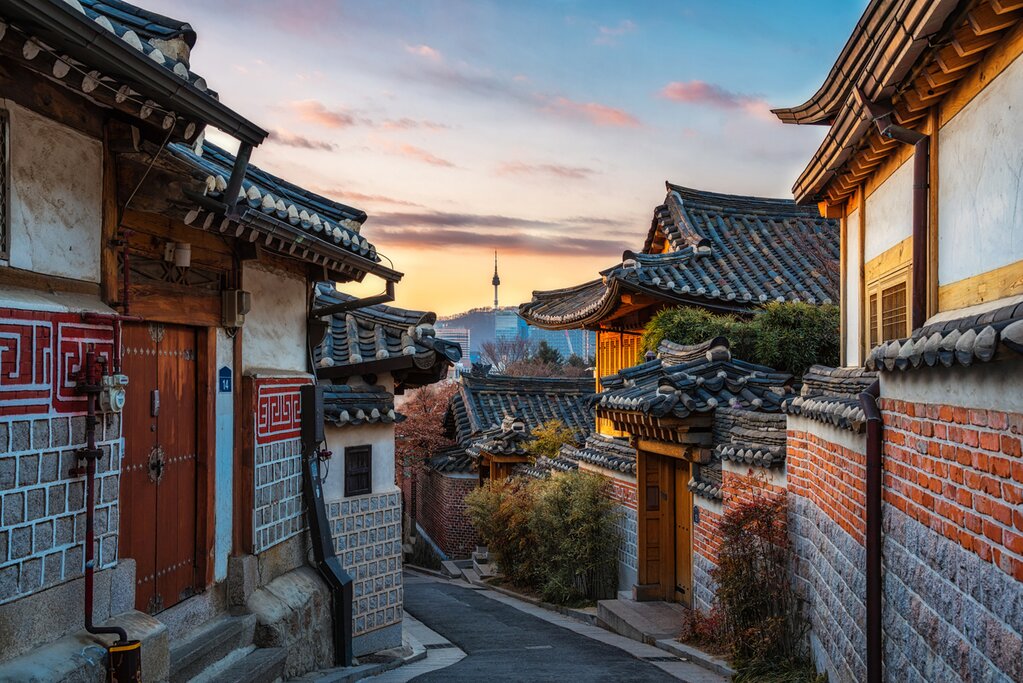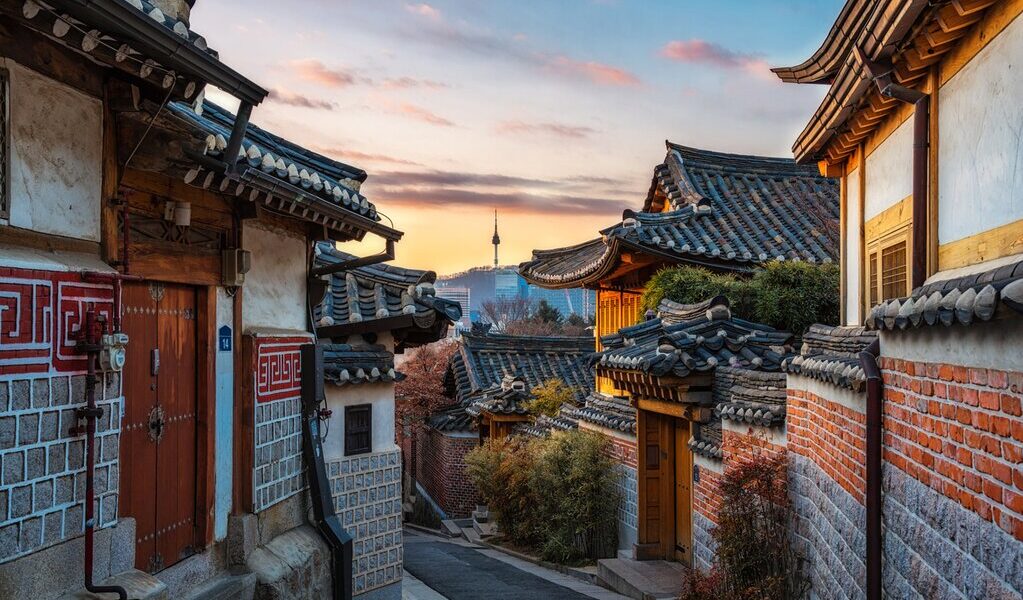
Experience South Korea at a seasonal crossroads in November, as fall gradually gives way to winter. Days are shortening, and temperatures falling, just as crowds and prices begin to decline. Spend the first two weeks of the month chasing the year’s final fall leaves, seen to best advantage in the south at Naejangsan National Park. Southern cities, including Jeonju and Gwangju, offer slightly warmer temperatures and the opportunity to dive into South Korea’s diverse history, culture, and gastronomy.
South Korea in November: A Comprehensive Travel Guide
November in South Korea marks a fascinating transition between the vibrant colors of autumn and the serene beauty of winter. This month presents a unique opportunity for travelers seeking a blend of pleasant weather, fewer crowds, and stunning landscapes. As the fall foliage season gracefully concludes, the country prepares for the embrace of winter, offering a distinct charm to those who venture to explore its diverse offerings.
Weather
November serves as the bridge between fall and winter in South Korea. The early days of the month provide a final chance to witness the splendor of autumn foliage, allowing visitors to capture the last glimpses of the breathtakingly colorful leaves before the arrival of winter’s chill. As the month progresses, the days gradually shorten, and temperatures begin to descend, with the average monthly temperature hovering around 41°F (5°C). As November draws to a close, temperatures have the potential to dip below the freezing point, and while snowfall remains relatively rare, it is certainly a possibility, adding a touch of magic to the landscape.
One of the appealing aspects of November in South Korea is its dryness. The month is characterized by low rainfall, making it one of the driest periods of the year. This dry weather, coupled with consistently low humidity levels, creates comfortable conditions for outdoor exploration and sightseeing. Travelers can anticipate crisp, clear days, ideal for immersing themselves in the country’s natural beauty and cultural attractions.
Crowds & Costs
As winter approaches and the peak tourist season subsides, South Korea experiences a reduction in crowds, leading to a corresponding decrease in prices. The beginning of November tends to be the busiest time of the month, as the weather remains mild, and the fall foliage continues to adorn the trees. However, even during this period, the crowds are generally smaller compared to the peak autumn months.
November presents an excellent opportunity to witness South Korea’s spectacular autumn foliage in a more tranquil setting. While the country’s national parks draw large crowds from mid-to-late October, November offers a chance to enjoy the vibrant colors with greater serenity. For those seeking the best leaf-peeping experience without the overwhelming crowds, arriving early in the day at popular destinations is highly recommended. This strategy allows visitors to secure prime viewing spots and fully appreciate the beauty of the autumn landscapes.
Planning a Trip to South Korea
To make the most of your trip to South Korea, consider consulting with a local specialist who can assist you in organizing your itinerary. Their expertise and knowledge of the region can help you create a personalized travel experience that caters to your specific interests and preferences.
Where to Go
The first half of November presents a wonderful opportunity to fully appreciate South Korea’s captivating autumnal scenery. Consider venturing south to Naejangsan National Park, renowned for its ideal late-season leaf viewing. The park transforms into a breathtaking tapestry of red and gold leaves, blanketing Naejangsan Mountain and the surrounding landscape in a vibrant spectacle. Visitors can ascend the mountain via cable car to reach the summit, which stands at 2,503 feet (763 m), offering panoramic views of the colorful panorama. Alternatively, numerous hiking trails wind through the park, catering to various fitness levels and providing opportunities for immersive exploration.
Seoul, located approximately 2.5 hours away by train, can serve as an excellent base for a day trip to Naejangsan National Park. After experiencing the natural beauty of the park, return to Seoul and indulge in the city’s diverse attractions. Enjoy an entertaining performance of Cookin’ Nanta, an internationally acclaimed non-verbal show that blends Korean percussion with comedy and culinary arts. Delve into the country’s rich history and cultural heritage at the National Museum of Korea, home to an extensive collection of artifacts spanning centuries. Conclude your day by exploring Insadong, a charming neighborhood known for its traditional crafts, tea houses, and upscale souvenir shops.
Alternatively, consider exploring southern cities like Jeonju or Gwangju, which offer shorter travel times to natural attractions and provide opportunities to delve into regional centers of gastronomy and culture. These cities boast unique culinary traditions and historical landmarks, providing a more localized experience.
For those seeking warmer weather, a southern or coastal city like Busan is an excellent choice. Busan offers stunning seaside views and pristine beaches, allowing visitors to enjoy the refreshing ocean air and bask in the coastal ambiance. Stroll along one of the city’s six beaches, each offering a distinct character and charm.
History enthusiasts will find Gyeongju, located in the southwest, to be a captivating destination. Gyeongju is home to more than 50 UNESCO World Cultural Heritage Sites and the country’s only national historic park. Immerse yourself in the city’s rich history as you explore ancient temples, royal tombs, and archaeological sites.
What to Do
Hiking and trekking are among the most popular activities at the beginning of November, as visitors seek out the most breathtaking autumn vistas. Naejangsan National Park offers a variety of trails suitable for all ability levels, allowing everyone to experience the beauty of the park’s fall foliage. As you hike, you can also visit one of the park’s historic temples, including Baegyangsa Temple and Naejangsa Temple, both renowned for their stunning architecture and serene atmosphere.
Travelers basing their trip in Gwangju can plan a visit to Mudeungsan National Park. Avid outdoors enthusiasts can challenge themselves by conquering the three peaks of Mudeungsan Mountain, collectively known as the “Jeongsang Three.” The panoramic views from the summit are well worth the effort, offering a glimpse of the surrounding landscape.
Embark on a culinary adventure in Jeonju, the birthplace of South Korea’s ubiquitous mixed rice dish, bibimbap, and a UNESCO Creative City for Gastronomy. Explore the historic hanok village, wandering through the narrow laneways lined with traditional Korean homes, offering a glimpse into the past. Discover the vibrant street art of Mural Village and visit the Gyeonggijeon shrine and Pungnammun Gate, historical landmarks that showcase the city’s rich heritage.
In nearby Gwangju, experience a bastion of South Korean culture nestled in the heart of the country’s mountains. Immerse yourself in the ancient history of the Joseon Dynasty at Namhan Fortress, a UNESCO World Heritage Site that offers panoramic views of the surrounding area. Learn about the country’s contemporary history at 5-18 Memorial Park, dedicated to the victims of the 1980 Gwangju Democratization Movement.
In Seoul and other major cities, explore top tourist attractions, scheduling outdoor sightseeing for midafternoon when temperatures are typically warmest. Especially cold days at the end of the month may call for a trip to one of South Korea’s famous bathhouses, jjimjilbang. These traditional bathhouses offer a variety of saunas, hot tubs, and relaxation areas, providing a perfect way to escape the cold and rejuvenate your body. Warm your bones with a bowl of hot noodle soup, a comforting and delicious treat.
Events in November
Cheongsong Apple Festival, Cheongsong: Participate in this annual festival held at the beginning of November and pick apples straight from the tree. Enjoy various apple-themed events and activities, celebrating the region’s famous fruit.
Geoje Island Flower Festival, Geoje: Admire exhibitions of fall flowers, including more than 100 chrysanthemum sculptures, at this fall festival held at the end of October and beginning of November. Immerse yourself in the beauty of nature’s colorful creations.
Masan Chrysanthemum Festival, Masan: Masan, responsible for farming more than 13% of the world’s chrysanthemums, hosts this festival annually to promote and celebrate the famous flower. Be mesmerized by the intricate displays and learn about the cultivation of these beautiful blooms.
B-2313

